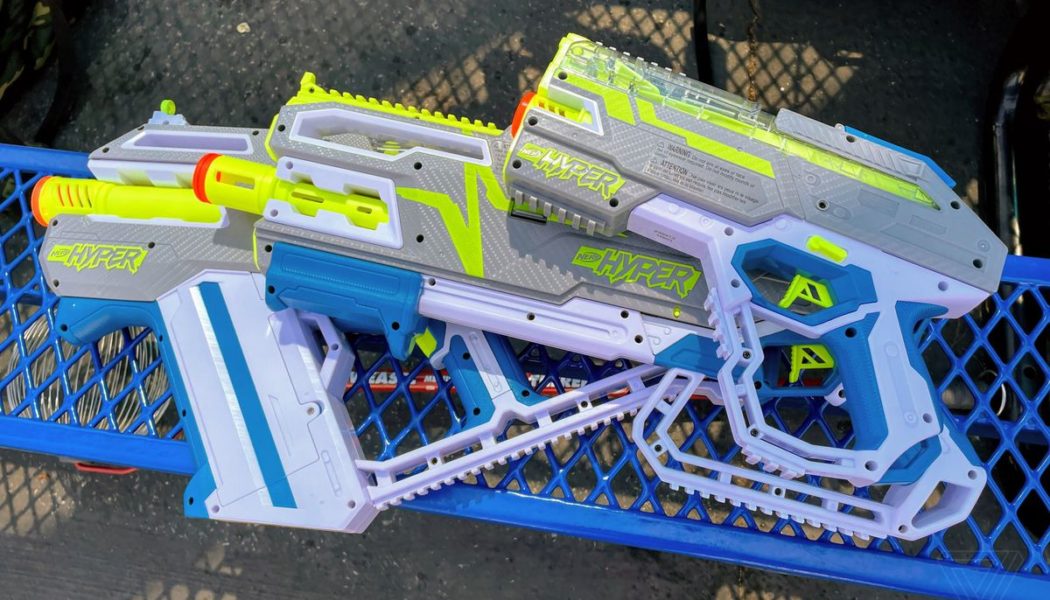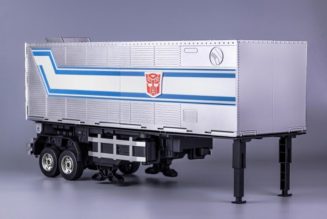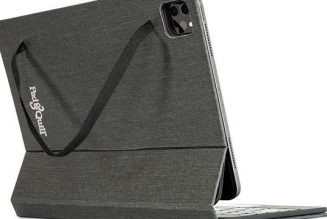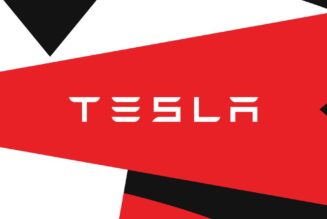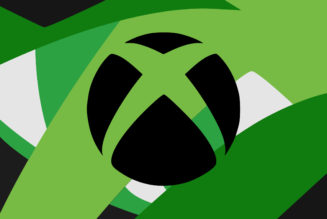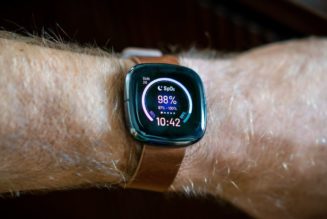For nearly 30 years, Nerf has been synonymous with foam — foam balls, foam darts, and foam arrows blasted across playgrounds or over cubicle walls.
For its new awesome-looking Hyper blasters, Nerf brand owner Hasbro had something different in mind. To increase their performance and capacity, it charged a small team of engineers to develop a smaller projectile using a new material. They came up with a tiny ball made of thermoplastic elastomer; effectively, rubber instead of foam.
Before they could perfect that ball, the company’s designers had to build a new set of blasters to actually fire those projectiles, too. The $30 Hyper Rush-40, $40 Siege-50, and $70 Mach-100 were developed at the same time as the new rounds, they told me on a conference call.
That might be why they don’t work particularly well.
I’ve been testing them in my local park, my backyard, and this past month, I got to try them at an actual Nerf war. Honestly, I can’t recommend them at all. And I’m still not sure whether it’s because the ammo has fundamental limitations, or whether this first wave of blasters just misses the mark.
Let’s discuss.
:no_upscale()/cdn.vox-cdn.com/uploads/chorus_asset/file/22835515/verge_sean_hollister_20210822_2.jpg)
Dream vs. reality
When I was a kid, you’d have to reload most Nerf blasters after every single shot. Only the biggest, bulkiest and most inaccurate two-handed toys let you do more. When I returned to Nerf as an adult, a five-shot revolver you could prime with your thumb was a revelation, and yet you’d still have to carry a bulky drum magazine to feed a rifle with more than 18 darts at a time. It was only 2017 when the company finally released a $100 blaster that could fit enough ammo to hold down a fort thanks to a gigantic hopper-fed system that held 100 rounds.
So when Nerf announced its new Hyper ammo was small enough to cram 40 shots into a pistol or 100 into an SMG-sized blaster, plus paintball-style canisters to top up, it sounded like a dream: we’d finally be able to battle without constantly thinking about the next reload.
Instead, I’m constantly thinking about whether my blaster will actually shoot when I pull the trigger.
:no_upscale()/cdn.vox-cdn.com/uploads/chorus_asset/file/22835611/verge_sean_hollister_20210907.jpg)
Whether you pick the Rush-40, Siege-50 or Mach-100, their integrated ammo boxes all rely on gravity to feed rounds into the chamber, and these rounds don’t always want to go in. If you actually stuff 40 tiny yellow balls into a Rush-40, or 50 of them into a Siege-50, they might not have enough room to reach the chute at all. Even if you don’t, they need to slide down the slope just right to reach the inner chamber. Mess it up, and nothing will happen when you pull the trigger, just a puff of air. So far, my best bet has been to point the blaster down to the ground each time I prime it — but that means not keeping it aimed at my target. It’s a real disadvantage in a fast-paced Nerf battle.
Even with the Mach-100, which has a dedicated mechanical agitator and conveyor belt to keep the balls moving, it can be a problem: the supposedly full-auto blaster would often pop just a few balls at a time, then pause, then fart out two at once, sometimes with dramatically reduced range.
:no_upscale()/cdn.vox-cdn.com/uploads/chorus_asset/file/22835554/verge_sean_hollister_20210907_9.jpg)
And even when they do fire, you can’t expect them to go anywhere near where their blaster’s built-in aiming sights are pointed. With the Rush-40 pistol and Mach-100 SMG in particular, their shots almost immediately curve right down to the ground, forcing you to aim much higher than your target and rain balls down. I did get some tags this way, though.
It also mystifies me why Hasbro produced paintball-like hoppers and pods for easy refills without giving them a way to mate. Every time I whip out one of the cool canisters, which smartly attach to each blaster’s built-in rails, I inevitably dump a bunch of them on the ground, because the loading doors and flip-top canister don’t match up at all. Hasbro designer Rob Maschin says the team would love to change that in the future.
This is all a shame, because in many ways these Hyper balls are the best projectiles Nerf’s made in years. While they’re the same dimpled shape as the company’s larger foam Rival balls, the new TPE rounds are far denser and fly further. They’re easy to wash, not terribly hard to pick up with a small nut gatherer, and their electric yellow makes them incredibly easy to spot on the ground. No word on whether they’re biodegradable should someone decide to be lazy, though.
“We produced probably a dozen different colors and just threw them out into a lawn out back to see which is easiest to see — that neon yellow popped,” Nerf brand manager Greg Nyland told me. It’s true: despite being smaller than Rival, they catch my eye at a distance.
:no_upscale()/cdn.vox-cdn.com/uploads/chorus_asset/file/22835532/verge_sean_hollister_20210516.jpg)
:no_upscale()/cdn.vox-cdn.com/uploads/chorus_asset/file/22835535/verge_sean_hollister_20210904.jpg)
You can even use a black light to find them at night, since they’re UV-reactive. They do bounce everywhere and roll all over the place, and could get lost in storm grates, but the only time I personally had trouble was in dense, clumpy grass where they’d fall into little pockets of turf and I had to be standing at the right angle to see them.
Perhaps as importantly, the blasters can spit out these rounds more powerfully than anything else Hasbro will let you buy on a shelf. I consistently saw all three blasters exceeding 100 feet per second on my chronograph, with the Rush-40 and Siege-50 regularly crossing the 115 feet per second mark. And while those balls did dive into the ground when I fired flat, I measured ranges of up to 150 feet with my distance measuring wheel after I angled shots up into the air.
:no_upscale()/cdn.vox-cdn.com/uploads/chorus_asset/file/22835543/verge_sean_hollister_20210907_4.jpg)
To get a sense of how much performance has changed, I compared the Hyper Rush-40 to the Rival Kronos — since the Rush is largely just a Kronos with the new projectiles on board. As you can see in the chart, the Rush’s maximum range absolutely dwarfs the Kronos, but at the expense of range when shot flat. With the old Kronos, I can sometimes hit things I see in my sights, but I found little reason to aim with Hyper.
Nerf Hyper Range Test
| Blaster | Distance (flat) | Distance (angled) |
|---|---|---|
| Blaster | Distance (flat) | Distance (angled) |
| Rush-40 | 45-60 ft | 135-140 ft |
| Rival Kronos | 60-65 ft | 80-110 ft |
| Siege-50 | 40-55 ft | 120-155 ft |
| DZ Conquest Pro | 60-70 ft | 120-145 ft |
| Mach-100 | 45-80 ft | 80-135 ft |
Range isn’t the whole story, though. The Hyper rounds hit harder (I asked friends to shoot me in the face), so it’s more obvious when you’ve been tagged. They travel faster and don’t loft in the air quite like Rival rounds, so they’ll likely be harder to dodge, too.
Speaking of lofting and range, Hasbro surprisingly omitted a feature from two of these blasters typically used to improve both: a little rubber nub called a “hop-up” that adds backspin to the ball, taking advantage of the Magnus effect to fly through the air. But the Rush-40 and Mach-100 mysteriously don’t have a hop-up, even though the Rival blasters they’re based on (the aforementioned Rival Kronos and Rival Perses) most definitely do. And while the Siege-50 has one, mine barely worked. Still, some Nerfers have already created 3D printed aftermarket hop-ups for the Rush-40 that seem to improve their accuracy. It’s likely Hasbro’s future Hyper blasters will, too.
I’m less certain why Hyper rounds feed so poorly, but I have a theory. To make them safe, Hasbro made them squishy, and now they’re too gummy to avoid sticking on each other when they’re crammed into a hopper. I imagine they could even jam blasters if not for the Hyper hoppers’ tilt-down-to-load feeding chutes, which ensure only one round gets chambered at a time.
:no_upscale()/cdn.vox-cdn.com/uploads/chorus_asset/file/22835619/verge_sean_hollister_20210907_6.jpg)
:no_upscale()/cdn.vox-cdn.com/uploads/chorus_asset/file/22835620/verge_sean_hollister_20210907_7.jpg)
It’s tricky. If Hasbro had simply made its foam Rival balls smaller, they would have been lighter too, which isn’t necessarily helpful for speed and accuracy. But if you make them denser to fix those things, they aren’t quite as soft — and as Hasbro veteran engineer Bob DeRoche explained on the call, every single blaster the company makes has to meet its Kinetic Energy Disbursement (KED) standard for safety. “Based on the speed, the weight, the diameter, and how much that disperses, you have to be under that KED number. If it’s under that, you’re safe — it’ll hurt your eye, it won’t feel good, but it won’t damage your eye, he says.”
Technically, every single Hyper blaster comes with a pair of safety glasses too — a first for a Nerf product, I believe — and prominent warning labels about wearing them in the field. But the primary safety mechanism was building a TPE pellet with the right squish, and the team admits that squish was a challenge for the blasters — which, remember, they had to develop simultaneously. “We didn’t have that luxury of time,” says DeRoche. “When we first got those samples of the round and got closer to what we wanted, we were still getting into the final state of not being as tacky or sticky,” adding that it was “problematic” to keep them fluffed and loose.
That’s why Hasbro decided to start with hopper-fed blasters to begin with, as opposed to compression feeding systems like a spring-loaded magazine. Nyland suggests we shouldn’t rule out other feeding mechanisms, though, pointing to just how much Nerf’s Rival line evolved since its 2015 debut, too. I have to admit he’s got a point: the first Rival blasters showed off serious potential, but their tiny magazines and terrible ergonomics were vastly improved just a couple years later. I’d be excited to see co-branded Halo, Overwatch and Star Wars blasters that can actually fit a decent number of shots inside, but I wonder whether the gummy rounds will ever work in a truly enclosed space.
The competition
But the real reason to skip Hyper — for now — isn’t any of these issues. It’s that Hyper doesn’t compete.
Not only does Hyper require you to buy into a new, unproven ammo type that likely won’t be available at your local Nerf war, Hasbro’s expecting teens and young adults to see them as the blaster of choice for sporting-grade Nerf, and that’s just not the reality today. The sporting part of the Nerf community is increasingly standardizing on half-length of the same size of dart that Hasbro’s blasters have used for years, to the point nearly every player at my last Nerf war had at least one short dart blaster in their loadout.
Modern short darts from brands like Worker and Dart Zone fly so straight you can consistently hit things you aim at. They’re cheap, too: typically between 8 and 10 cents per dart, compared to the 15 to 21 cents you’ll pay per Hyper ball right now.
:no_upscale()/cdn.vox-cdn.com/uploads/chorus_asset/file/22835617/verge_sean_hollister_20210907_10.jpg)
And you don’t need to buy the kind of incredible 3D printed blasters we featured here to get started, because an upstart rival named Dart Zone is making it increasingly easy to get into short darts, too. For the same $40 you’d pay for Hasbro’s Hyper Siege-50, you could hit up a Walmart for the similar pump-action-shotgun-esque Dart Zone Conquest Pro instead, and have 15 darts that actually fly where you aim them with just as much power and without the feeding issues. $10 more buys a pair of additional magazines or 100 additional darts, compared to $12 (on sale!) for a canister of just 50 Hyper rounds.
I was able to keep some foes pinned down with the Mach-100, and I got some tags with the others too, but I spent most of my time wishing I had something more reliable to use.
Perhaps the biggest thing I don’t understand about Hasbro’s foam-flinging strategy is why it let this competition go unchecked, instead of building better darts itself. It was Nerf that popularized the foam dart some 29 years ago, but the competition’s short darts and even full-lengths fly so much better than any projectile Hasbro has ever made. Perhaps that’s intentional for safety reasons, or for fun? (I do remember when dodging darts all Matrix-style was a great part of the game.) But Walmart seems perfectly happy to carry Dart Zone’s more powerful and accurate blasters, and without requiring bundled safety glasses.
Maybe Hyper will surprise us, but after this slow start and the company’s forgettable Ultra and Elite 2.0 lines (both of which performed worse than previous blasters in a number of ways), I’m hoping Hasbro might take a harder look at how it can truly compete.
